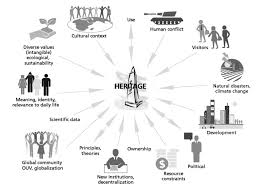The Importance of Cultural Heritage
Cultural heritage is the legacy of physical artefacts and intangible attributes of a group or society that are inherited from past generations, maintained in the present, and passed on to future generations. It plays a crucial role in shaping our identities, fostering a sense of belonging, and connecting us to our roots.
Preservation of History
One of the key aspects of cultural heritage is its role in preserving history. Through monuments, sites, traditions, and practices, we can trace back the evolution of societies, understand their values and beliefs, and learn from their experiences. By conserving cultural heritage, we ensure that future generations have access to this wealth of knowledge.
Promotion of Diversity
Cultural heritage celebrates diversity by showcasing the unique customs, languages, arts, and cuisines of different communities around the world. It reminds us that there are multiple ways of living and thinking, fostering tolerance and respect for other cultures. Embracing cultural diversity enriches our lives and promotes a more inclusive society.
Economic Benefits
Cultural heritage also contributes to economic development by attracting tourists, creating jobs in sectors such as tourism and conservation, and stimulating local economies. Historic sites, museums, festivals, and traditional crafts draw visitors from far and wide, generating revenue for communities and preserving their way of life.
Social Cohesion
Cultural heritage plays a vital role in promoting social cohesion by bringing people together through shared experiences and traditions. Festivals, rituals, storytelling sessions, and community events create bonds among individuals and foster a sense of unity within societies. Cultural heritage serves as a unifying force that transcends differences and builds bridges between people.
Challenges in Preservation
Despite its significance, cultural heritage faces numerous challenges such as natural disasters, urbanisation, conflicts, neglect, vandalism, and climate change. Efforts must be made to safeguard these valuable assets through conservation projects, legal protection measures, public awareness campaigns, and international cooperation.
Conclusion
In conclusion,
cultural heritage is an invaluable treasure that must be cherished,
protected,
and shared for the benefit of present
and future generations.
By recognising
the importance
of our diverse
cultural legacies,
we can
preserve
our collective memory,
nurture
our identities,
and promote
a more harmonious world.
Let us
embrace
and safeguard our cultural heritage as a testament to our shared humanity.
Understanding and Preserving Cultural Heritage: Answers to Common Questions
- What is cultural heritage?
- Why is cultural heritage important?
- How is cultural heritage preserved?
- What are examples of cultural heritage?
- How does cultural heritage contribute to identity?
- What threats does cultural heritage face?
- How can individuals help protect cultural heritage?
What is cultural heritage?
Cultural heritage encompasses the tangible and intangible assets inherited from past generations that define a society’s identity and values. It includes historical sites, artefacts, traditions, languages, rituals, and knowledge systems that are preserved and passed down to future generations. Cultural heritage serves as a reflection of a community’s history, beliefs, and achievements, shaping its collective memory and fostering a sense of belonging among its members. By safeguarding cultural heritage, we honour the diversity of human experiences and ensure that our rich cultural tapestry remains vibrant for years to come.
Why is cultural heritage important?
Cultural heritage holds immense importance as it serves as a bridge between the past, present, and future, shaping our identities and connecting us to our roots. It preserves history, traditions, values, and knowledge passed down through generations, offering insights into the evolution of societies. Cultural heritage promotes diversity by celebrating unique customs and fostering mutual respect among different cultures. Furthermore, it contributes to economic development through tourism and job creation while promoting social cohesion by uniting communities through shared experiences and traditions. Ultimately, cultural heritage is a testament to our shared humanity and must be cherished, preserved, and shared for the enrichment of present and future generations.
How is cultural heritage preserved?
Cultural heritage is preserved through a combination of proactive measures and dedicated efforts aimed at safeguarding the physical, intangible, and digital aspects of a community’s legacy. Conservation practices such as restoration of historical sites, artefacts, and monuments play a crucial role in maintaining the physical integrity of cultural heritage. Additionally, documentation, digitisation, and archival initiatives help capture intangible elements like traditions, rituals, languages, and knowledge systems for future generations. Legal frameworks, funding support, community involvement, education programmes, and international collaboration also contribute significantly to the preservation of cultural heritage by ensuring its protection, promotion, and sustainable management. By adopting a holistic approach that combines traditional wisdom with modern technologies and global cooperation, cultural heritage can be effectively safeguarded for posterity.
What are examples of cultural heritage?
Cultural heritage encompasses a vast array of tangible and intangible examples that reflect the traditions, beliefs, practices, and values of a particular community or society. Examples of cultural heritage include historical sites like the Pyramids of Egypt, iconic landmarks such as the Taj Mahal in India, traditional festivals like Carnival in Brazil, indigenous crafts such as Navajo weaving in the United States, classical music compositions like Beethoven’s symphonies in Germany, and oral traditions like storytelling among Aboriginal communities in Australia. These diverse examples of cultural heritage serve as windows into the rich tapestry of human creativity and expression across different regions and time periods.
How does cultural heritage contribute to identity?
Cultural heritage plays a fundamental role in shaping individual and collective identities. By preserving and passing down traditions, beliefs, languages, arts, and customs from one generation to the next, cultural heritage provides a sense of continuity and connection to our roots. It helps us understand where we come from, who we are, and where we belong in the world. Cultural heritage acts as a mirror reflecting our shared history and values, allowing us to celebrate our uniqueness while also fostering a sense of belonging to a larger community. Through the preservation and promotion of cultural heritage, individuals can explore their own identities, appreciate diversity, and build bridges with others who share similar cultural backgrounds.
What threats does cultural heritage face?
Cultural heritage faces a myriad of threats that endanger its preservation and continuity. Urbanisation poses a significant risk as rapid development often leads to the destruction or alteration of historic sites and traditional landscapes. Natural disasters such as earthquakes, floods, and wildfires can devastate cultural treasures, causing irreparable damage. Furthermore, conflicts and wars can result in intentional destruction of heritage sites as collateral damage or as acts of cultural erasure. Climate change also poses a threat, with rising sea levels and extreme weather events endangering coastal heritage sites. Neglect, vandalism, looting, and inadequate funding for conservation efforts further exacerbate the challenges faced by cultural heritage today. Efforts to address these threats require coordinated action at local, national, and international levels to safeguard our shared heritage for future generations.
How can individuals help protect cultural heritage?
Individuals play a crucial role in protecting cultural heritage by taking proactive steps to safeguard and promote these invaluable assets. One way individuals can contribute is by raising awareness about the importance of cultural heritage within their communities and advocating for its preservation. Supporting local cultural initiatives, visiting heritage sites responsibly, and participating in cultural events are other ways to show appreciation for our shared history. Additionally, respecting and learning about different cultures, traditions, and practices help create a more inclusive society that values and preserves its diverse heritage for future generations to cherish. By actively engaging with and respecting cultural heritage, individuals can play a significant part in its protection and promotion.




